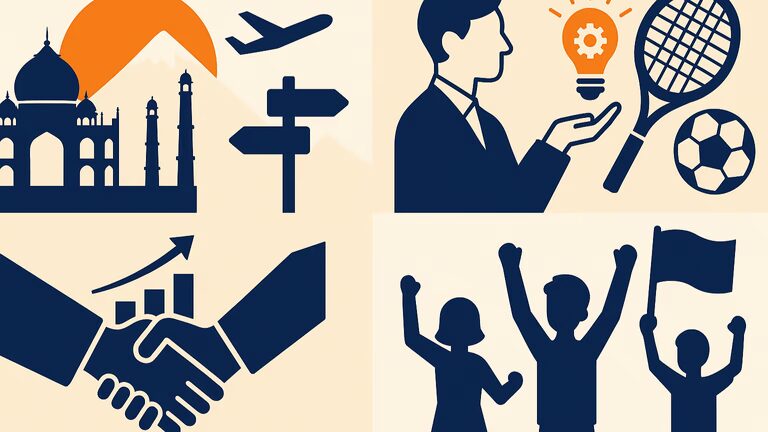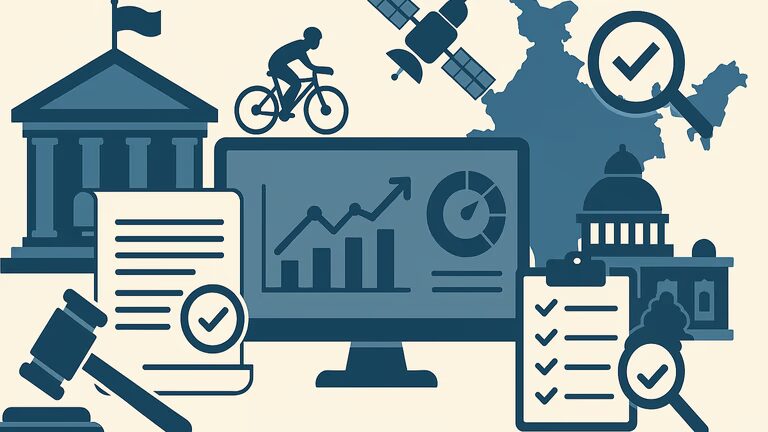
Under the Chairperson, Prime Minister Narendra Modi, the Union Cabinet on July 1, 2025, approved the National Sports Policy (NSP) 2025 and referred to it as Khelo Bharat Niti 2025. It is a visionary document that engages sports as a mechanism of national development. NSP 2025 has taken the place of the much older 2001 one and aims to help fulfil its aspirations of being termed a sporting nation on the global map, with particular emphasis on the 2036 Olympic Games.
Here we will discuss the major highlights of the policy, its strategic pillars, and its overarching effects on sports, economy, education, and society.
ALSO READ- China’s Blackout Bomb
Background and Significance-
- Supersedes: National Sports Policy 2001
The 2001 policy has been overtaken by events in today’s global environment. It did not even bother to have mechanisms for grassroots integration. NSP 2025 brings modern frameworks in sync with changes brought about by international standards and technology advancements.
To Envision: Make India a World Leader in Sports-
The objective of the policy is to strive towards India as a new world of sports profession and lifestyle activities. It is going to focus on inclusion, health, and youth empowerment through sports avenues.
Central Ministries and NITI Aayog:
- Consultations were held with various stakeholder groups for the bigger strategy to ensure that plans are implemented in synergy with national development plans and flagship schemes of the government.
- Cross-sectoral inputs have been integrated from the health, education, tourism, and urban planning sectors.
State Governments:
- They were encouraged to make their own State Sports Policies with both technical and financial support.
National Sports Federations (NSFs):
- The disqualified management sets consults on athlete development, governance reforms, and participation in global events.
- They also participated in the design of training modules, ranking systems, and infrastructure development.
- From the general public to the athletes, coaches, and experts.
- Public consultations, surveys, and stakeholder meetings were used to obtain responses from the general public.
- Athletes shared lived experiences concerning welfare policies that are athlete-centric.
Excellence on the Global Stage-
Objectives:
- Making India a top contender in global sports.
- Provide world-class support and training for the elite athletes.
Key Actions:
- Coalition of Local to National Programs.
- Identify potential talent early with programs from schools and districts.
- Developing strong feeder systems for professional training.
Infrastructure Development:
- Investment in stadiums and training centres throughout rural and urban India.
- Support to States/UTs regarding regional sports complexes.
High-performance Ecosystems:
- Set up national centres of excellence for priority sports.
- Training facilities, coaching, and sports science of world standards.
Sports Technology and Science:
- Artificial intelligence (AI), data analytics, and performance diagnostics.
- Mainly, injury prevention and sports medicine.
Sports for Economic Development-
Considering sports as a major economic driver, NSP 2025 has emphasised the industrial, entrepreneurial, and global opportunities in sports.
Key Provisions:
- Boost Sports Tourism.
- Attract global sporting events to various Indian cities.
- Promote India as a hub for high-altitude training and wellness-based tourism.
- Develop regional sports circuits to become a part of annual tourism calendars.
- Create “sports tourism zones” with dedicated infrastructure and allied services.

Foster Sports Start-ups & Manufacturing:
- To build an ecosystem around Indian-made sports goods.
- Start nurturing incubation for fitness tech and athlete services Start-ups.
- Grant financial incentives and tax benefits to MSMEs related to sports.
- Facilitate access to research and development labs and sports innovation hubs for product development.
Public Private Partnerships (PPPs):
- Mobilising Corporate Funds Using CSR.
- Creating Joint Ventures for Sports Infrastructure and League Operations.
- Land allotment and ease of doing business for private sports academies.
- Launching co-branded community sports programs aimed at youth for large-scale engagement.
Sports for Social Development-
Sports are a tool for inclusion, empowerment, and nation-building. The following are the focus areas:
Equity and Access:
- Programs for women, tribal groups, PWDS and EWS students.
- Outreach to underrepresented regions through mobile academies.
Preservation of Indigenous Games:
- Modernisation and promotion of traditional Indian sports.
- Organisation of festivals and leagues showcasing regional games.
Sports as a Carrier:
- Inclusion of sports in career counselling in schools.
- Dual career pathways for athletes (education + sports).
Global Indian Engagement:
- Engagement of the Indian diaspora through sports diplomacy.
- Encourage NRI support for talent scouting and mentorship.
Sports as a People’s Movement-
To promote a sporting culture throughout India, NSP 2025 envisions that sports become a national lifestyle habit.
Mass Participation Campaigns:
- Community tournaments and school fests.
- National mass awareness campaigns for sports and fitness.
Fitness Index Launch:
- Strictly monitors fitness at schools, colleges, and workplaces.
- Publicly recognises top-performing institutions.
Universal Access to Facilities:
- Community engagement in open government and private sports facilities.
- Setting up of ‘open gyms’ and play zones in each district.
Integration with NEP 2020: Sports & Education-
Education is a critical pillar in the national sports policy of education, A key aspect of this vision is the integration of sports into mainstream education and developmental provisions that were made by the National Education Policy (NEP) of 2020. Its major initiatives are:
Curriculum Fusion:
- Formal subject for sports.
- Performance and grading recognition of physical education.
Teacher Employment:
- Specific modules for PE teachers and coaches.
- Innovation of BPEd and MPEd courses to suit modern needs.
Sports Labs & Clubs:
- Schools and colleges encouraged to create “sports labs” for early exposure.
- Participation of each student in at least one sporting event in a year.
Strategic Framework & Implementation-
The NSP 2025 describes a multi-pronged approach for the realisation of its vision.
Core Mechanisms:
- Governance Reforms.
- New legal frameworks regulating athlete welfare, sports federations, and doping.
- Increased autonomy for sporting institutions, with clearly defined performance KPIs.
Innovation & Technology:
- Performance dashboards in real-time for athletes and federations.
- Satellite information and AI for infrastructure planning.
Surveillance & Evaluation:
- National standards for benchmark measures for all stakeholders.
- Third-party audits and annual reports.
The Model State Policy:
- As a guide for States or UTs toward National Goals, NSP 2025 would serve as a national platform.
- Central assistance is also tied to how State policy premises develop.
- Whole of Government Approach.
- Ministries will incorporate sports into their flagship schemes-health, tourism, youth affairs, women & child development, etc.

Conclusion: The Renaissance of India in Sports-
More than just a map, the National Sports Policy 2025 can even become a national impetus. Inclusive, performance-oriented, and future-ready, the policy sets India en route to becoming a global sporting superpower.
It turns into a healthy and united nation through mass participation in sports. A thriving web of athletes, trainers, startups, and innovators. From hosting international tournaments to discovering local talent in remote villages, the next big east is now making India a “Sports First” nation through NSP 2025.
